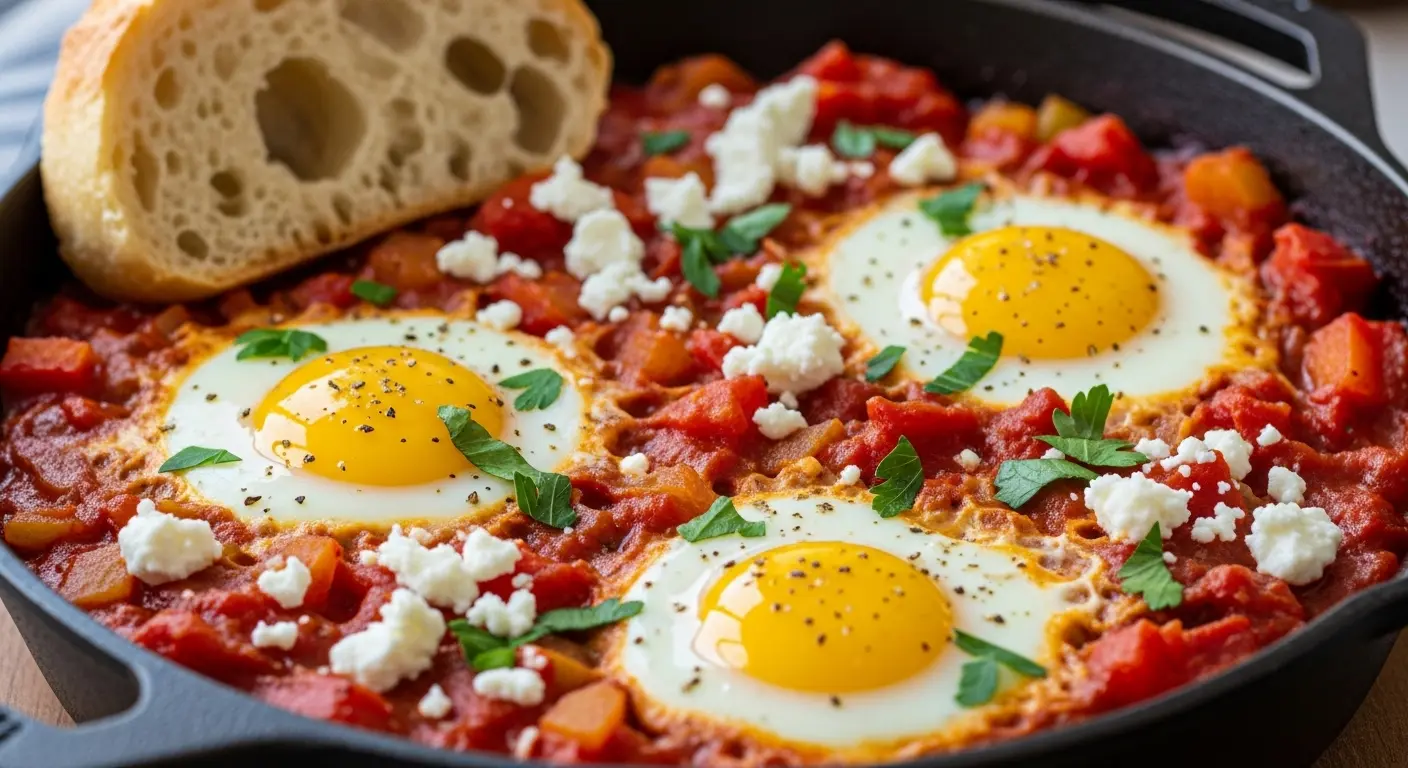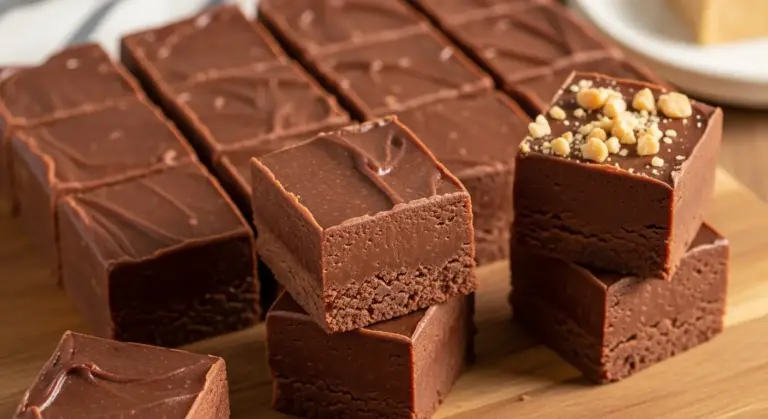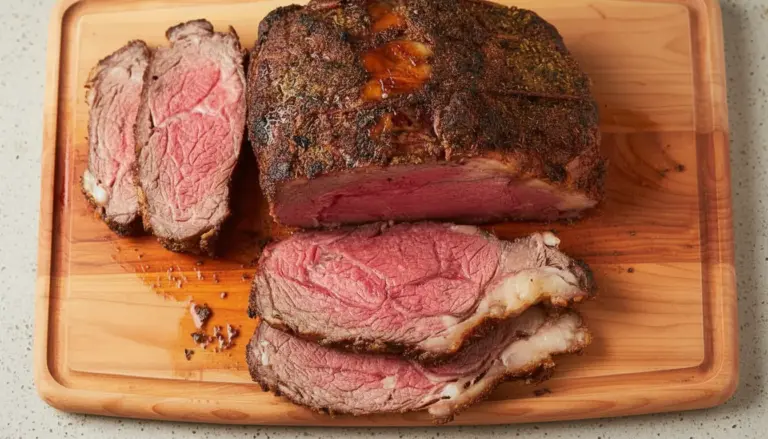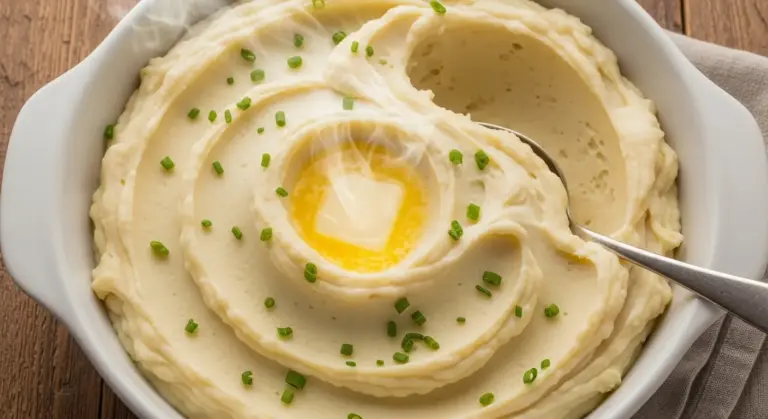I never expected a dish of poached eggs in spicy tomato sauce to become my Saturday morning ritual, but here we are. The first time I made shakshuka was on a lazy weekend when I had nothing but canned tomatoes, eggs, and a lonely bell pepper in my fridge.
My partner was skeptical when I told them breakfast would be “eggs cooked in sauce,” but one bite changed everything. The runny yolks mixing with the rich, spiced tomato base, scooped up with crusty bread, was nothing short of magical.
Now, this shakshuka recipe is my go-to whenever I want something special but don’t want to spend hours in the kitchen. It looks impressive, tastes incredible, and uses ingredients you probably already have on hand.
| Quick Recipe Summary | |
|---|---|
| Prep Time | 10 minutes |
| Cook Time | 25 minutes |
| Total Time | 35 minutes |
| Servings | 4 servings |
| Difficulty Level | Easy |

Why You’ll Love This Shakshuka Recipe
This dish has become my answer to everything from brunch guests to “what’s for dinner” nights. It’s one of those rare recipes that feels fancy but requires minimal effort and basic pantry staples.
The beauty of shakshuka lies in its versatility and forgiving nature. You can make it spicy or mild, add vegetables you need to use up, or keep it simple with just tomatoes and eggs.
Here’s what makes this recipe special:
- Ready in 35 minutes from start to finish, making it perfect for weekend brunch or a quick weeknight dinner
- One pan meal that means minimal cleanup and maximum flavor
- Naturally gluten-free and vegetarian while still being incredibly satisfying
- Budget-friendly since eggs and canned tomatoes are affordable staples
- Impressive presentation that makes it look like you spent hours cooking
- Customizable heat level so you can adjust the spice to your preference
- Works for any meal whether breakfast, lunch, or dinner
For another hearty breakfast burrito recipe, check out my filling morning favorite.
Ingredients
The ingredient list is surprisingly simple, which is part of what makes this dish so approachable. I’ve learned through trial and error which components are essential and which ones you can play with.
- 2 tablespoons olive oil (30ml)
- 1 large onion, diced (about 1½ cups or 200g)
- 1 red bell pepper, diced (about 1 cup or 150g)
- 4 garlic cloves, minced
- 1 teaspoon ground cumin (2g)
- 1 teaspoon paprika (2g)
- ½ teaspoon cayenne pepper (1g), adjust to taste
- 1 can (28 oz or 800g) crushed tomatoes
- 2 tablespoons tomato paste (30g)
- 1 teaspoon salt (6g), or to taste
- ½ teaspoon black pepper (1g)
- 1 teaspoon sugar (4g), optional
- 6 large eggs
- ¼ cup fresh parsley, chopped (15g)
- ¼ cup crumbled feta cheese (40g), optional
- Crusty bread for serving
Kitchen Equipment Needed
Having the right tools makes this recipe even easier to execute. I learned the hard way that a too-small skillet leads to crowded eggs that don’t cook properly.
- Large cast iron skillet or heavy-bottomed pan (12-inch or 30cm diameter)
- Wooden spoon for stirring
- Sharp knife for chopping vegetables
- Cutting board
- Can opener
- Measuring spoons
- Small bowls for cracking eggs (to avoid shell pieces)
- Lid or large plate to cover the skillet
Recommended Products for This Recipe
After making shakshuka countless times, I’ve found a few products that truly make a difference in the final result. These aren’t just nice-to-haves; they genuinely improve the cooking process and the taste.
1. Lodge Cast Iron Skillet 12-Inch
The even heat distribution of a good cast iron skillet is crucial for shakshuka because it keeps the tomato sauce at the perfect simmer while gently cooking the eggs. I’ve tried making this in regular pans, and the results just don’t compare. Plus, cast iron can go from stovetop to oven if you want to finish your eggs under the broiler for set whites with runny yolks.
2. San Marzano Crushed Tomatoes
Not all canned tomatoes are created equal, and San Marzano tomatoes make a noticeable difference in the sauce’s sweetness and depth of flavor. They’re less acidic and have a richer taste than regular canned tomatoes. Since the tomato sauce is the base of this dish, using quality tomatoes elevates everything.
3. Smoked Spanish Paprika
Regular paprika is fine, but smoked paprika adds an incredible depth and a subtle smokiness that makes people ask, “What’s in this?” It’s one of those secret ingredients that takes the dish from good to unforgettable without being overwhelming.
4. Authentic Feta Cheese in Brine
While optional, good quality feta in brine (not the pre-crumbled kind) adds a creamy, tangy element that balances the spiced tomato sauce beautifully. The brine-packed version stays moist and crumbles perfectly over the finished dish.

Step-by-Step Instructions: How to Make Shakshuka
I’m going to walk you through this process exactly as I make it every time. The key to great shakshuka is building layers of flavor and not rushing the sauce.
1. Prepare Your Vegetables
- Dice the onion into roughly ½-inch (1cm) pieces, keeping them relatively uniform so they cook evenly
- Cut the red bell pepper into similar-sized pieces, removing all seeds and white membranes
- Mince the garlic cloves finely, or use a garlic press if you prefer
- Chop the fresh parsley and set it aside for garnishing later
- If using feta, crumble it into bite-sized pieces and keep it chilled until ready to serve
2. Start the Sauce Base
- Heat the olive oil in your large skillet over medium heat for about 1 minute until it shimmers but doesn’t smoke
- Add the diced onion and cook for 5-6 minutes, stirring occasionally, until softened and just starting to turn golden at the edges
- Add the bell pepper and continue cooking for another 4-5 minutes until it begins to soften
- If the vegetables start to brown too quickly, reduce the heat slightly to prevent burning
3. Build the Spice Layers
- Push the vegetables to the sides of the pan to create a small well in the center
- Add the minced garlic to the well and cook for 30-45 seconds until fragrant but not browned
- Stir in the cumin, paprika, and cayenne pepper, coating the vegetables evenly with the spices
- Toast the spices for about 1 minute, stirring constantly, which releases their essential oils and deepens their flavors
- Be careful not to let the spices burn, as they can turn bitter very quickly
4. Create the Tomato Sauce
- Add the tomato paste to the center of the pan and cook it for 1-2 minutes, stirring it into the vegetables gradually
- Pour in the crushed tomatoes, using the back of your spoon to scrape up any browned bits from the bottom of the pan
- Season with salt, black pepper, and sugar if using (the sugar helps balance the acidity of the tomatoes)
- Stir everything together thoroughly, making sure the spices are evenly distributed throughout the sauce
- Bring the mixture to a gentle simmer, then reduce heat to low and let it cook uncovered for 10-12 minutes, stirring occasionally
- The sauce should thicken slightly and the flavors will meld together; if it seems too thick, add a splash of water
5. Poach the Eggs
- Use the back of your spoon to create 6 small wells in the simmering sauce, spacing them evenly around the pan
- Crack each egg into a small bowl first (this prevents shell pieces and gives you more control), then gently slide it into one of the wells
- The egg whites should be mostly submerged in the sauce while the yolks sit on top
- Cover the skillet with a lid or a large plate to trap the steam
- Cook for 5-8 minutes depending on how runny you like your yolks; I prefer mine at 6 minutes for just-set whites with creamy yolks
- Don’t move the eggs while they’re cooking, or you’ll break the yolks
6. Finish and Serve
- Once the egg whites are set but the yolks are still soft, remove the skillet from heat immediately
- Sprinkle the fresh parsley and crumbled feta cheese (if using) over the top
- Season with an extra pinch of salt and pepper if needed
- Serve directly from the skillet at the table for a beautiful presentation, with plenty of crusty bread on the side for dipping
You might also enjoy: French Toast Recipe

Tips for The Best Shakshuka
I’ve made shakshuka dozens of times, and through lots of experimenting (and a few mediocre attempts), I’ve learned what really makes this dish shine.
Master these techniques for perfect shakshuka every time:
- Don’t rush the base: Cook the onions and peppers until they’re properly softened; this sweetness balances the acidity of the tomatoes
- Adjust the spice level: Start with less cayenne if you’re heat-sensitive; you can always add hot sauce at the table
- Use room temperature eggs: Cold eggs from the fridge take longer to cook and can cool down your sauce too much
- Make wells properly: The wells should be deep enough that the egg whites are mostly covered by sauce, which helps them cook through
- Watch the eggs closely: The difference between perfectly runny and overcooked yolks is just 1-2 minutes
- Let it rest briefly: Give the dish 2-3 minutes off the heat before serving so the eggs finish cooking gently with residual heat
- Taste and adjust: Always taste your sauce before adding the eggs and adjust the salt, spice, and acidity levels
- Use fresh spices: Old, stale spices won’t give you the vibrant flavor this dish deserves
- Don’t skip the bread: It’s essential for soaking up the delicious sauce and runny yolks
- Preheat your skillet: A properly heated pan ensures even cooking and prevents sticking
Read Also: Pumpkin French Toast Recipe
Serving Suggestions
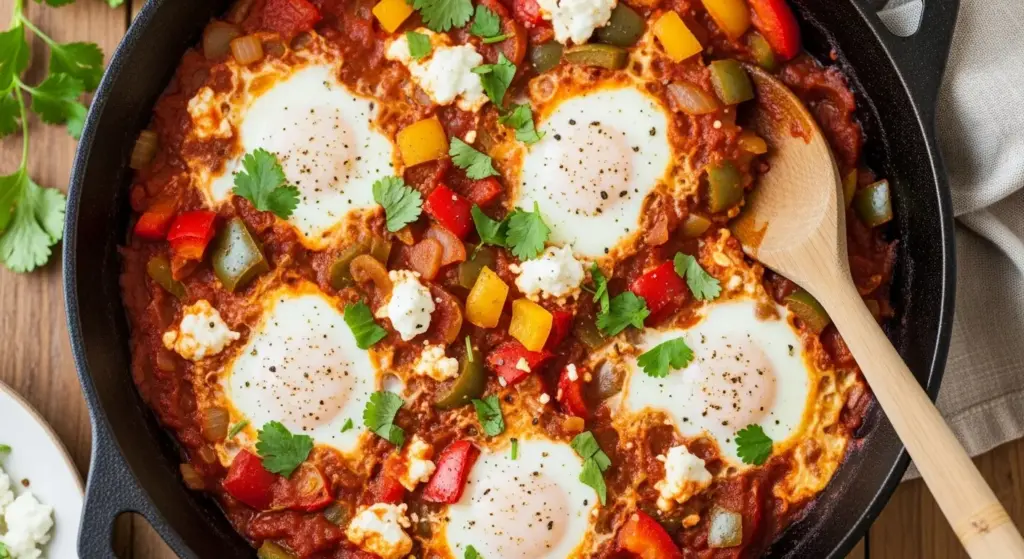
Shakshuka is hearty enough to be a complete meal, but I love pairing it with a few complementary sides that soak up that incredible sauce and round out the flavors.
Serve this dish family-style right from the skillet with warm, crusty bread for dipping. I usually put out some deviled eggs as an appetizer while the shakshuka finishes cooking.
Here are my favorite accompaniments:
- Crusty bread or pita: Essential for mopping up every last drop of sauce; I warm mine in the oven for 5 minutes before serving
- Greek yogurt or labneh: A dollop of tangy yogurt on the side helps cool down the spice and adds creaminess
- Simple green salad: A light salad with lemon vinaigrette provides a fresh contrast to the rich eggs and sauce
- Hummus and vegetable sticks: Healthy hummus with crisp cucumbers, carrots, and bell peppers adds texture and freshness
- Olives and pickles: Briny, tangy pickled vegetables complement the rich tomato sauce beautifully
- Fresh herbs platter: Set out extra parsley, cilantro, and mint for people to add as they like
- Tahini drizzle: A light drizzle of tahini sauce adds nutty richness and authentic Middle Eastern flavor
- Israeli salad: Finely diced tomatoes, cucumbers, and onions with lemon juice make a refreshing side
Variations of Shakshuka
One of the best things about this recipe is how easily it adapts to different tastes and what you have on hand. I’ve tried countless variations over the years, and here are the ones worth making again.
Transform your shakshuka with these delicious twists:
- Green shakshuka: Replace the tomato sauce with a base of sautéed spinach, chard, or kale mixed with cream or coconut milk for a completely different but equally delicious version
- Meat lover’s version: Add cooked ground lamb, beef, or crumbled sausage to the sauce before adding eggs for extra protein and heartiness
- Spicy harissa shakshuka: Stir in 2-3 tablespoons of harissa paste for North African heat and complex spice flavors
- Cheesy shakshuka: Add shredded mozzarella or goat cheese on top during the last minute of cooking for melty, gooey goodness
- Bean and chickpea version: Stir in a can of drained chickpeas or white beans for added fiber and to make it more filling
- Smoky eggplant shakshuka: Add roasted eggplant cubes to the tomato sauce for a richer, smokier flavor profile
- Breakfast shakshuka: Top with crumbled breakfast sausage and serve with hash browns on the side
- Mediterranean style: Add sun-dried tomatoes, artichoke hearts, and kalamata olives to the base sauce
- Sweet potato shakshuka: Stir in roasted sweet potato cubes for natural sweetness and extra nutrients
- Creamy shakshuka: Swirl in a few tablespoons of heavy cream or coconut cream just before adding the eggs
Another favorite: Tandoori Chicken Recipe
Storage and Reheating
While shakshuka is best enjoyed fresh from the pan, I’ve definitely made extra and stored it successfully for busy mornings when I want something quick but satisfying.
Here’s how to store and reheat shakshuka properly:
- Refrigerator storage: Let the shakshuka cool completely, then transfer to an airtight container and refrigerate for up to 3 days
- Separate storage method: Store the sauce and eggs separately if possible; reheat the sauce and add fresh eggs for the best texture
- Freezing the sauce: The tomato sauce base freezes beautifully for up to 3 months; freeze in portions for quick weeknight meals
- Don’t freeze cooked eggs: The eggs don’t freeze well and become rubbery, so only freeze the sauce base
- Stovetop reheating: Reheat the sauce in a skillet over medium-low heat until simmering, then crack fresh eggs into it
- Microwave method: Reheat individual portions in the microwave in 30-second intervals, stirring between each until heated through
- Meal prep tip: Make a double batch of the sauce on Sunday and keep it in the fridge; crack fresh eggs into it throughout the week
- Revive dried-out sauce: Add a splash of water or tomato juice when reheating if the sauce has thickened too much
- Avoid overcooking on reheat: Keep the heat low and gentle to prevent the eggs from becoming tough and rubbery
For another make-ahead breakfast, try my air fryer morning frittata.
Nutritional Facts
Here’s the approximate nutritional information per serving (based on 4 servings, including feta and olive oil):
- Calories: 245
- Total Fat: 15g
- Saturated Fat: 4g
- Cholesterol: 285mg
- Sodium: 780mg
- Total Carbohydrates: 15g
- Dietary Fiber: 4g
- Sugars: 9g
- Protein: 13g
- Vitamin A: 35% DV
- Vitamin C: 85% DV
- Calcium: 12% DV
- Iron: 18% DV
Note: Nutritional values are approximate and will vary based on specific ingredients and portion sizes used.
Health Benefits of Key Ingredients
Beyond being delicious, shakshuka is actually loaded with nutrients that make it a genuinely healthy choice for any meal of the day.
The combination of eggs, tomatoes, peppers, and spices creates a nutrient-dense dish that supports overall health while satisfying your taste buds. I love that I can enjoy something this flavorful while also nourishing my body.
Here are the health benefits hiding in your shakshuka:
- Eggs: Packed with high-quality protein, choline for brain health, and all nine essential amino acids your body needs; the yolks contain lutein and zeaxanthin for eye health
- Tomatoes: Rich in lycopene, a powerful antioxidant that’s even more bioavailable when cooked; also provides vitamin C, potassium, and folate
- Bell peppers: Exceptionally high in vitamin C (more than oranges), plus vitamin A, B6, and antioxidants that support immune function
- Onions and garlic: Contain sulfur compounds that support heart health, have anti-inflammatory properties, and may help lower blood pressure
- Cumin: Aids digestion, helps regulate blood sugar, and contains iron; it’s been used medicinally for centuries
- Paprika: Contains capsaicin (even the mild varieties) which can boost metabolism and has anti-inflammatory properties
- Olive oil: Provides heart-healthy monounsaturated fats and anti-inflammatory compounds; use extra virgin for maximum benefits
- Parsley: More than a garnish, it’s rich in vitamins K, C, and A, plus acts as a natural breath freshener
Read Also: Chickpea And Spinach Curry Recipe
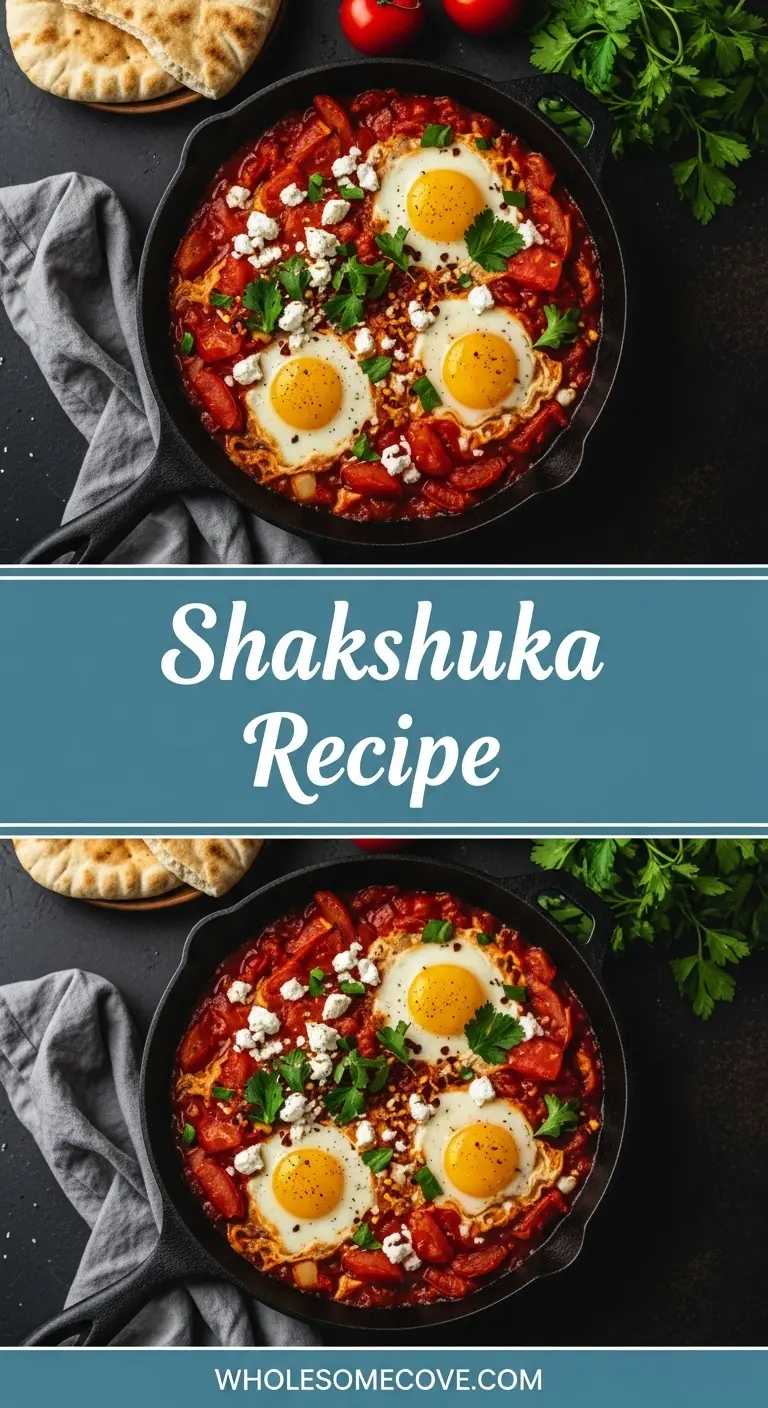
FAQs About Shakshuka
1. Can I make shakshuka ahead of time?
Yes, you can prepare the tomato sauce base up to 3 days in advance and store it in the refrigerator. When you’re ready to serve, simply reheat the sauce in your skillet until it’s simmering, then crack the eggs into it and cook as directed.
I actually prefer making the sauce the night before because the flavors develop and deepen overnight. Just don’t add the eggs until you’re ready to eat for the best texture.
2. Why are my egg whites still runny after cooking?
Runny whites usually mean the eggs weren’t covered during cooking or the heat was too low. The steam trapped under the lid is crucial for cooking the whites while keeping the yolks soft.
Make sure your sauce is at a gentle simmer (not just warm) before adding the eggs, and use a tight-fitting lid. If your whites are still undercooked after 8 minutes, you can carefully transfer the skillet to a preheated 375°F (190°C) oven for 3-4 minutes to finish them.
3. Can I make shakshuka without eggs?
Absolutely, though you’ll want to add another protein source to keep it filling. Try adding chickpeas, white beans, or cubed tofu to the sauce.
For a complete vegetarian meal without eggs, I recommend adding extra vegetables like zucchini, mushrooms, or eggplant, and serving it over couscous or rice. You can also crumble tempeh into the sauce for a different texture and protein boost.
4. What’s the best bread to serve with shakshuka?
Crusty sourdough, ciabatta, or traditional pita bread are my top choices because they’re sturdy enough to scoop up the sauce without falling apart. The bread should have some heft to it.
I like to brush slices with olive oil and toast them in the oven until golden and crispy. If you can find fresh-baked bread from a local bakery, even better. For a gluten-free option, toasted gluten-free sourdough or corn tortillas work well.
5. How do I prevent the eggs from overcooking?
The secret is removing the skillet from heat when the whites are just set but still look slightly glossy, not completely opaque. They’ll continue cooking from residual heat for another 1-2 minutes.
I also recommend checking the eggs starting at the 5-minute mark and every minute after that. Everyone’s stovetop is different, so trust your eyes more than the timer. If you prefer firmer yolks, simply leave them covered for 1-2 minutes longer.
You might also enjoy: Healthy Egg Salad Recipe
Final Thoughts
This shakshuka recipe has earned its place as a staple in my kitchen, and I hope it becomes one of yours too. The combination of perfectly poached eggs nestled in spiced tomato sauce is comforting, satisfying, and impressive without being fussy.
Give this recipe a try this weekend, and don’t be afraid to make it your own by adjusting the spice level or adding your favorite vegetables. I’d love to hear how your shakshuka turns out, so drop a comment below and share your experience or any creative variations you tried!
Recommended:
- Breakfast Burrito Recipe
- French Toast Recipe
- Air Fryer Morning Frittata Recipe
- Deviled Eggs Recipe
- Healthy Egg Salad Recipe
- Air Fryer Egg Recipes
- Chicken And Egg Salad Recipe
- Air Fryer Avocado Egg Rolls Recipe
- Air Fryer Turkey Scotch Eggs Recipe
- Pumpkin French Toast Recipe

